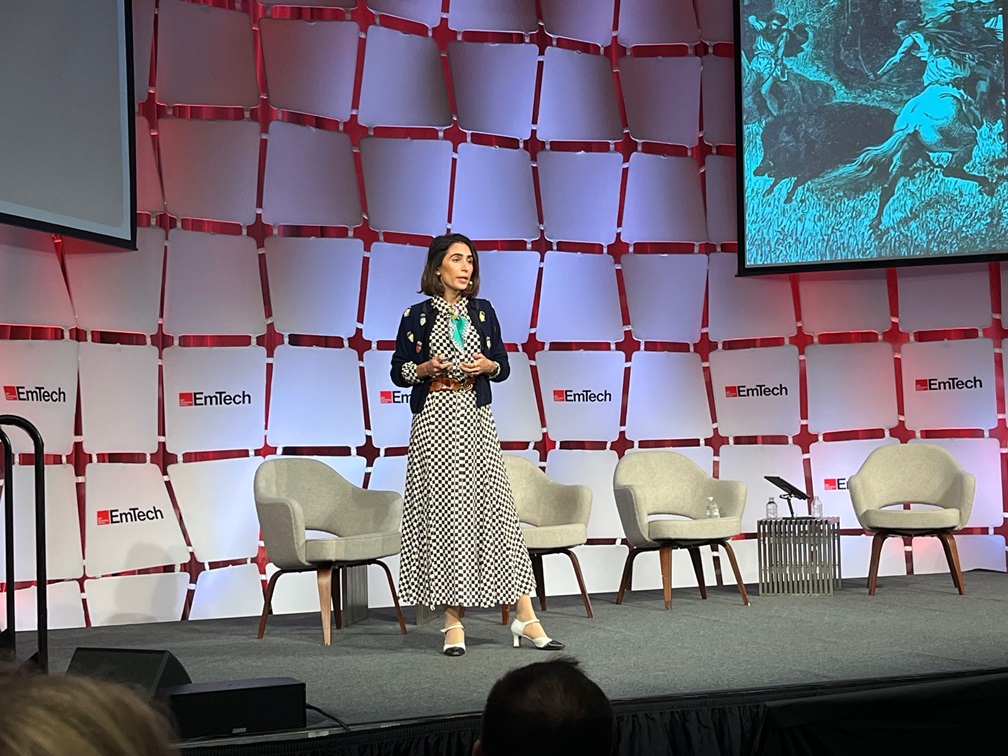 AI
AI
 AI
AI
 AI
AI
The power of the internet and the growing use of artificial intelligence are going to change how the world defines trust.
Tell signs for this shift can be seen among online users in Gen Z, the generation of 13- to 24-year-olds. Jigsaw, a subsidiary within Google LLC, conducted a study earlier this year that found young Gen Z users would read a headline first and then the comments section, often skipping the content of an article entirely. The younger generation is outsourcing truth and importance to online influencers and their own circle of friends.
“Trust has not evaporated,” said Yasmin Green (pictured), chief executive officer of Jigsaw. “It has migrated.”
Green spoke during a presentation at EmTech MIT 2024, a conference held annually at the MIT Media Lab in Boston. The event, produced by MIT Technology Review, was a gathering of scientific researchers, MIT faculty and tech company executives who provided insight into a future that will be defined by how the world adapts to the speed and convergence of technology innovation.
The migration of online trust identified by Jigsaw is having on impact on the advertising world in particular. At The Brandtech Group, a marketing technology firm that specializes in digital-only solutions, representatives have been working with clients to navigate shifting interests among online audiences in an effort to find the greatest source of influence.
“Brands used to be defined by what brands say to people, now it’s what people say to people,” Rebecca Sykes, partner at The Brandtech Group, who presented at the conference on Tuesday, told SiliconANGLE. “We absolutely do believe in that social-first mentality. We have a mantra for our clients, they have to ‘live in the feed.’”
Living in the feed also means being able to track and respond to how large language models are defining client brands. The Brandtech Group pays close attention to how LLMs impact client perception through the four functions of search, share, shop and scroll as performed by models from Google’s Gemini, OpenAI, Meta Platforms Inc. and Amazon.com Inc.’s Rufus.
Knowing each model’s preferences is the key to message optimization, according to Sykes. “You can target a particular perception change in a particular channel,” Sykes explained. “We can get quite specific about what to make to create reception change and I don’t think marketing has ever had it.”
On the flip side of the digital marketplace, content creators have been whipsawed between the need for cultivating a vast audience and being able to get paid for it. Trust in fair rights compensation has become a more significant issue over the past year as the owners of some popular AI models have been gobbling up content without compensating owners of the intellectual property or IP.
Story Protocol is an intellectual property-tracking blockchain network founded to help content creators protect IP. The world saw a prime example of how the freewheeling digital ecosystem has failed to protect content rights when former president Donald Trump was targeted in an assassination attempt in July.
A photo of the bleeding ex-president being escorted off the stage with his fist raised was taken by a photographer from the Associated Press. Within hours, the shot was redistributed globally in the form of memes, re-edited versions and even marketed by the candidate’s own organization, all royalty-free.
In an EmTech presentation, Story co-founder Jason Zhao described how his firm is seeking to digitally protect content rights and provide a mechanism for royalties akin to an application programming interface in software.
“It’s almost like an API for rights for every single piece of content,” Zhao said. “It’s all about ownership so creators can set the terms. Now the world not only has the ability to create, but also to monetize.”
Story Protocol, which has been funded by the crypto arm of noted venture capital firm Andreessen Horowitz, has attracted attention because of its blockchain solution. Transactions on the blockchain platform generally require a fee, known as gas, and Zhao was asked about this arrangement during his appearance at the conference.
“It’s the concept of IP as a network that everyone can contribute to,” Zhao said. “Do I pay 10 cents for gas or $10,000 for a lawyer?”
The solutions on display at EmTech involving the advertising and IP worlds highlighted a key takeaway from the two-day event. The technology world is adjusting on the fly to the impact of both AI and the astonishing speed in which something as basic as a photo can be remixed and redistributed for a vast array of additional purposes.
Even the largest tech players are being forced to spend time observing how this scenario is playing out. Will Grannis, vice president and chief technology officer at Google Cloud, provided a hint of this in his presentation on Monday, while confirming that the company’s own customers were not waiting to integrate AI into workflows.
“Customers are flipping the switch from prototypes to production,” Grannis said. “We listen. We’re really trying to sort out what they are doing with the technology. The mantra is to enable choice for our customers.”
This push for flexibility has become necessary as the technology moves at the speed of light, carried along by a wave of interest in AI. Yet artificial intelligence is not the only trend on the horizon that will reshape the world.
According to Amy Webb, CEO of the Future Today Institute, two additional general-purpose solutions will set a course for the rest of this decade. These will be biotechnology and advanced sensors which, in combination with AI, will create a flywheel effect with significant societal impact.
“You can think of this as a technology ‘supercycle,’ these are converging technologies that are starting to help each one move faster,” said Webb. “We are at the very beginning of a long-term change. Tomorrow is going to look quite different from today.”
THANK YOU